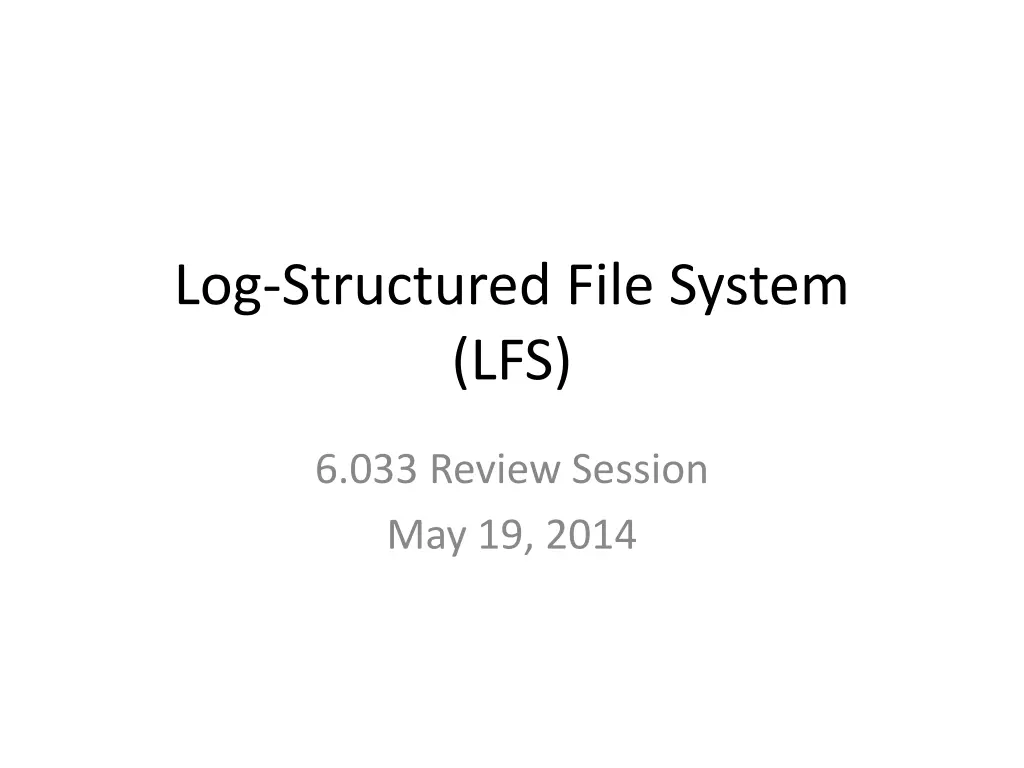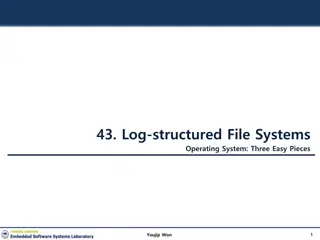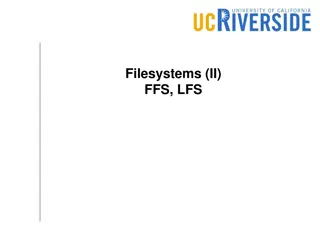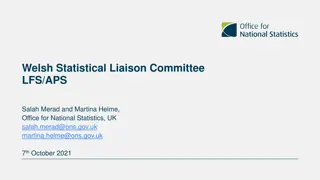
Understanding Log-Structured File System (LFS)
Explore the concept of Log-Structured File System (LFS) - a solution designed to optimize disk access by writing data sequentially, thereby reducing the cost of random access. Learn about the background problem, data structures used in LFS, and the efficiency comparison with traditional file systems.
Download Presentation

Please find below an Image/Link to download the presentation.
The content on the website is provided AS IS for your information and personal use only. It may not be sold, licensed, or shared on other websites without obtaining consent from the author. If you encounter any issues during the download, it is possible that the publisher has removed the file from their server.
You are allowed to download the files provided on this website for personal or commercial use, subject to the condition that they are used lawfully. All files are the property of their respective owners.
The content on the website is provided AS IS for your information and personal use only. It may not be sold, licensed, or shared on other websites without obtaining consent from the author.
E N D
Presentation Transcript
Log-Structured File System (LFS) 6.033 Review Session May 19, 2014
Background Problem: Sequential HD access is cheap, random access is expensive (true in 1991 and today) Standard UNIX file system does lots of random access for small file writes (small reads OK due to caching) Solution: Design a new kind of file system that always writes data sequentially at the end of the disk
Data Structures in LFS Same as in UNIX File System Superblock (fixed position on disk) Inode Blocks containing file data or directory listings Indirect Block Used to Maintain Log Structure Inode map (replaces the itable / inode table in the UNIX FS; no longer in a fixed position on disk) Used to optimize cleaning Segment summary Segment usage table Used to handle crash recovery Checkpoint region (fixed position on disk, incl. pointers to inode map blocks) Directory change log
Data Structures in LFS Same as in UNIX File System Superblock (fixed position on disk) Inode Blocks containing file data or directory listings Indirect Block Used to Maintain Log Structure Inode map (replaces the itable / inode table in the UNIX FS; no longer in a fixed position on disk) Used to optimize cleaning Segment summary Segment usage table Used to handle crash recovery Checkpoint region (fixed position on disk, incl. pointers to inode map blocks) Directory change log
Create file1/file2 in dir1/dir2: Without LFS = Disk Seek
Create file1/file2 in dir1/dir2: With LFS Boom. = Disk Seek
Create file1/file2 in dir1/dir2: With LFS = Disk Seek
Whats the Catch? Eventually we ll reach the end of the disk As files are deleted, freed data blocks leave holes in the previously contiguous log If we simply fill in the holes, we re be back to standard UNIX FS performance (probably worse)
Free Space Management Solutions LFS uses combination; copy-and-compact 512KB segments but thread compacted segments into open spaces in the log Why 512KB? Makes seek time neglibible.
Data Structures in LFS Same as in UNIX File System Superblock (fixed position on disk) Inode Blocks containing file data or directory listings Indirect Block Used to Maintain Log Structure Inode map (replaces the itable / inode table in the UNIX FS; no longer in a fixed position on disk) Used to optimize cleaning Segment summary Segment usage table Used to handle crash recovery Checkpoint region (fixed position on disk, incl. pointers to inode map blocks) Directory change log
Data Structures in LFS Same as in UNIX File System Superblock (fixed position on disk) Inode Blocks containing file data or directory listings Indirect Block Used to Maintain Log Structure Inode map (replaces the itable / inode table in the UNIX FS; no longer in a fixed position on disk) Used to optimize cleaning Segment summary: Information that allows block liveness to be determined Segment usage table: Statistics used to rank which segments to clean first Used to handle crash recovery Checkpoint region (fixed position on disk, incl. pointers to inode map blocks) Directory change log
Data Structures in LFS Same as in UNIX File System Superblock (fixed position on disk) Inode Blocks containing file data or directory listings Indirect Block Used to Maintain Log Structure Inode map (replaces the itable / inode table in the UNIX FS; no longer in a fixed position on disk) Used to optimize cleaning Segment summary: Information that allows block liveness to be determined Segment usage table: Statistics used to rank which segments to clean first Used to handle crash recovery Checkpoint region (fixed position on disk, incl. pointers to inode map blocks) Directory change log






















